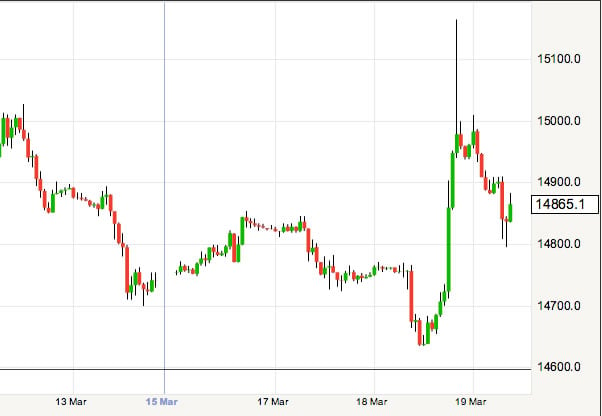Pound / Dollar on Rough Seas, Outlook Remains Negative
- Written by: Gary Howes
The dollar exchange rate complex (USD) came under significant selling pressure in the wake of the much-hyped FOMC event, only to recapture all losses within hours.
“There seems to be a growing consensus among FOMC members that it may be preferable to tighten later and catch up if needed than to tighten early” - ANZ Bank.
Our predictions of an overdue rally being in the air for the pound to dollar exchange rate (GBPUSD) were proved correct when the GBP shot back above the 1.51 threshold following the US FOMC event.
Those with currency purchase requirements who were wise enough to have buy orders set at these levels will have staged nothing short of a coup; we don't see such levels being reached for some time.
The rally higher was impressive.
Speculative traders saw their protective stop-losses being triggered on the move higher - a scenario that saw even more dollars dumped onto the market creating a cascading effect in which stop-loss levels further up the tree were hit and the GBPUSD climbed like wildfire.
It seems much of the crowded positioning may have been rinsed out rather quickly though and a discounted dollar only sucked in more traders looking to profit on the well-established trend.
At the time of writing we see the pairing at 1.4746, this is well down from the maximum of 1.5164 seen overnight. The minimum seen leading into the Fed was at 1.4634 suggesting we are back at square one.
"Sterling ducked back below $1.50 after a stomach-churning, rollercoaster session Wednesday ended up being the pound’s best one-day outing in 5 ½ years," says Joe Manimbo at Western Union.
Bank of England's Haldane Torpedoes Sterling Recovery
One of the culprits for the sudden reversal in the pound dollar exchange rate is the Bank of England's Chief Economist Andrew Haldane.
Haldane has said he does not see any reason why the Bank of England should not cut interest rates further.
"My view would be that policy may need to move off either foot in the immediate period ahead, depending on which way risks break,” Haldane told an audience at a BizClub lunch.
The talk was completely unexpected and with GBP currently priced for interest rate hikes in the future markets were exposed as being over-generous on current pricing.
We would caution those watching Sterling that more talk from the Bank of England could be possible in coming weeks as part of a 'jawboning' strategy by the Bank to keep GBP valuations supressed.
Why Did the US Dollar Under Pressure?
Fed Chairman Yellen, in the delivery of the latest Federal Open Market Committee (FOMC) minutes, has said the US inflation profile had softened.
Furthermore the Fed sounded a cautious tone saying, “economic growth had moderated somewhat.”
Inflation is the key concern to central bankers when they maintain low interest rates - the dynamic being that a high supply of money to the economy brought about by low rates pushes inflation to damaging levels.
Please note, that all levels mentioned here refer to the wholesale market. Your bank will affix a discretionary spread when transferring money internationally. However, an independent provider will seek to undercut your bank's offer, thereby delivering up to 5% more currency in some instances. Please learn more.
The absence of inflation means the US Fed, like the Bank of England, can keep rates lower for longer.
The US Dollar rally has been fuelled by investors demanding USD in preparation for the higher yields prompted by rate hikes.
Commenting on the FOMC, ANZ Bank say:
“After all the hoopla, in the event, the Fed looks like it has flinched – the recent run of soft US data presumably the culprit.
“There seems to be a growing consensus among FOMC members that it may be preferable to tighten later and catch up if needed than to tighten early and possibly have to unwind if the economy falters.
“The Fed’s 50bp lower “dot plot” for the Fed Funds rate and lower GDP and Core PCE projections all send a very dovish message, offsetting any “harm” dropping the word “patient” may have caused.
“Equity markets liked it, bonds rallied sharply, and the USD sunk.”
Bank of England in No Hurry to Raise Rates Either
The GBP, while up against the USD, has had a stinker of a day.
Given, the outlook for the pound sterling remains bullish in the long-term, but near-term corrections lower are needed to ensure the rally is sustainable.
The latest phase of the corrective move lower came when the BoE MPC Minutes showed the vote remained at 9-0.
Some industry commentators had expected a number of members to start voting for a hike.
The Minutes lacked enthusiasm noting downside risks in regards to the inflation outlook, partly countered by a more upbeat outlook on the labour market.
The BoE noted that the improvement in labour market conditions suggested that the unemployment rate may reach 5.3% by the middle of the year.
However, sterling bulls will take heart from the Bank noting that the “churn” rate has continued to pick up likely reflecting improved confidence by employees over their work and wage prospects.
The Minutes also highlighted the risk that the recent appreciation in GBP/EUR could “prolong” the period for which inflation remained below target.
“Overall, the BoE is likely to be on the side-lines for some time with potential policy tightening unlikely to occur until Q4 2015 at the earliest,” say ANZ.
After recent falls we note the pound to dollar exchange rate is oversold, confirmed by a Relative Strength Index reading of 28.0 on the daily chart.
Anything below 30 indicates oversold conditions. We would expect consolidation from here.
Strategically I am backing a return to at least the 1.50 congestion zone.






